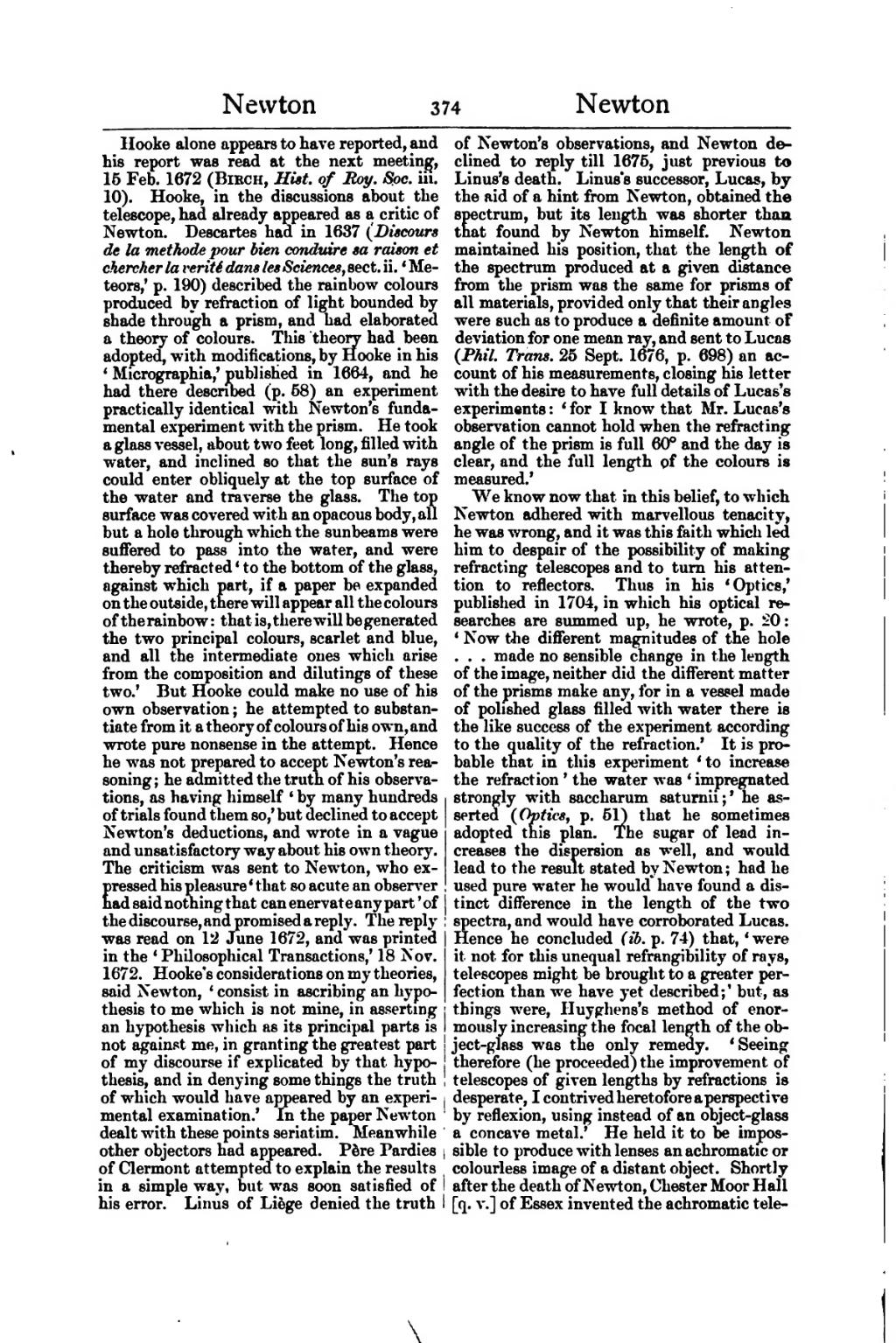Hooke alone appears to have reported, and his report was read at the next meeting, 15 Feb. 1672 (Birch, Hist. of Roy. Soc. iii. 10). Hooke, in the discussions about the telescope, had already appeared as a critic of Newton. Descartes had in 1637 (Discours de la méthode pour bien conduire sa raison et chercher la verité dans les Sciences, sect. ii. ‘Meteors,’ p. 190) described the rainbow colours produced by refraction of light bounded by shade through a prism, and had elaborated a theory of colours. This theory had been adopted, with modifications, by Hooke in his ‘Micrographia,’ published in 1664, and he had there described (p. 58) an experiment practically identical with Newton's fundamental experiment with the prism. He took a glass vessel, about two feet long, filled with water, and inclined so that the sun's rays could enter obliquely at the top surface of the water and traverse the glass. The top surface was covered with an opacous body, all but a hole through which the sunbeams were suffered to pass into the water, and were thereby refracted ‘to the bottom of the glass, against which part, if a paper be expanded on the outside, there will appear all the colours of the rainbow: that is, there will be generated the two principal colours, scarlet and blue, and all the intermediate ones which arise from the composition and dilutings of these two.’ But Hooke could make no use of his own observation; he attempted to substantiate from it a theory of colours of his own, and wrote pure nonsense in the attempt. Hence he was not prepared to accept Newton's reasoning; he admitted the truth of his observations, as having himself ‘by many hundreds of trials found them so,’ but declined to accept Newton's deductions, and wrote in a vague and unsatisfactory way about his own theory. The criticism was sent to Newton, who expressed his pleasure ‘that so acute an observer had said nothing that can enervate any part’ of the discourse, and promised a reply. The reply was read on 12 June 1672, and was printed in the ‘Philosophical Transactions,’ 18 Nov. 1672. Hooke's considerations on my theories, said Newton, ‘consist in ascribing an hypothesis to me which is not mine, in asserting an hypothesis which as its principal parts is not against me, in granting the greatest part of my discourse if explicated by that hypothesis, and in denying some things the truth of which would have appeared by an experimental examination.’ In the paper Newton dealt with these points seriatim. Meanwhile other objectors had appeared. Père Pardies of Clermont attempted to explain the results in a simple way, but was soon satisfied of his error. Linus of Liège denied the truth of Newton's observations, and Newton declined to reply till 1675, just previous to Linus's death. Linus's successor, Lucas, by the aid of a hint from Newton, obtained the spectrum, but its length was shorter than that found by Newton himself. Newton maintained his position, that the length of the spectrum produced at a given distance from the prism was the same for prisms of all materials, provided only that their angles were such as to produce a definite amount of deviation for one mean ray, and sent to Lucas (Phil. Trans. 25 Sept. 1676, p. 698) an account of his measurements, closing his letter with the desire to have full details of Lucas's experiments: ‘for I know that Mr. Lucas's observation cannot hold when the refracting angle of the prism is full 60° and the day is clear, and the full length of the colours is measured.’
We know now that in this belief, to which Newton adhered with marvellous tenacity, he was wrong, and it was this faith which led him to despair of the possibility of making refracting telescopes and to turn his attention to reflectors. Thus in his ‘Optics,’ published in 1704, in which his optical researches are summed up, he wrote, p. 20: ‘Now the different magnitudes of the hole … made no sensible change in the length of the image, neither did the different matter of the prisms make any, for in a vessel made of polished glass filled with water there is the like success of the experiment according to the quality of the refraction.’ It is probable that in this experiment ‘to increase the refraction’ the water was ‘impregnated strongly with saccharum saturnii;’ he asserted (Optics, p. 51) that he sometimes adopted this plan. The sugar of lead increases the dispersion as well, and would lead to the result stated by Newton; had he used pure water he would have found a distinct difference in the length of the two spectra, and would have corroborated Lucas. Hence he concluded (ib. p. 74) that, ‘were it not for this unequal refrangibility of rays, telescopes might be brought to a greater perfection than we have yet described;’ but, as things were, Huyghens's method of enormously increasing the focal length of the object-glass was the only remedy. ‘Seeing therefore (he proceeded) the improvement of telescopes of given lengths by refractions is desperate, I contrived heretofore a perspective by reflexion, using instead of an object-glass a concave metal.’ He held it to be impossible to produce with lenses an achromatic or colourless image of a distant object. Shortly after the death of Newton, Chester Moor Hall [q. v.] of Essex invented the achromatic tele-
